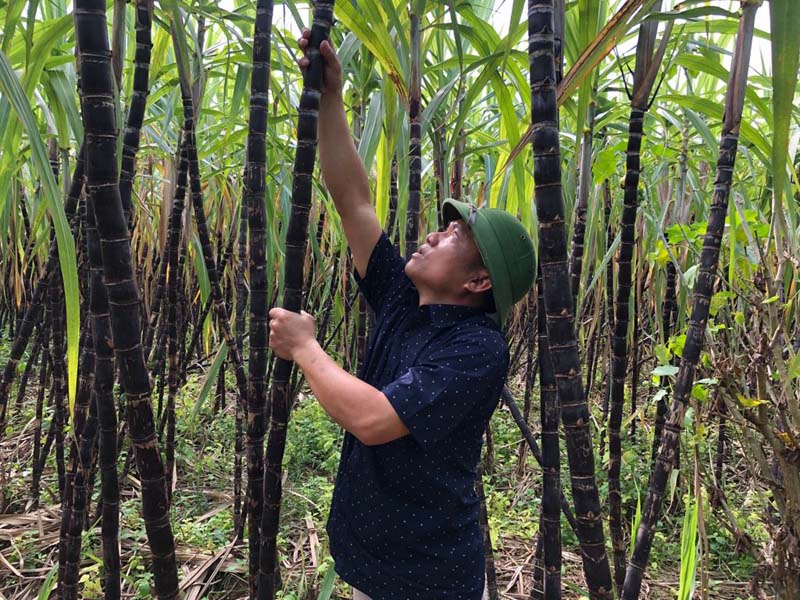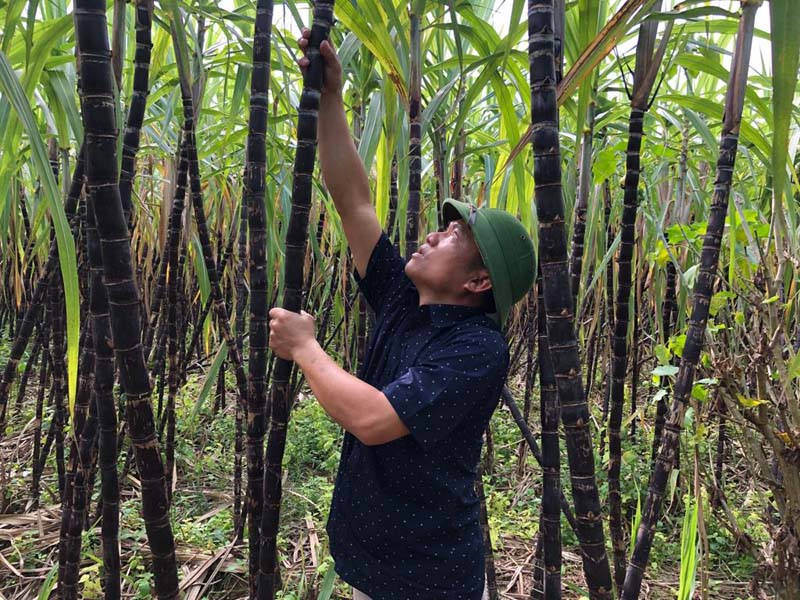
(HBO) – Since 2016, tissue culture sugarcane has been put into production in Hoa Binh province to gradually replace the local purple sugarcane variety which has been degraded through many years of cultivation. This model is part of a project replacing the purple sugarcane variety with tissue culture sugarcane implemented by the local centre for application of scientific-technological advances.
 Farmers
in Treo Ngoai hamlet, Nam Phong commune (Cao Phong district), grow tissue
culture sugarcane, which has proved superior economic efficiency.
Farmers
in Treo Ngoai hamlet, Nam Phong commune (Cao Phong district), grow tissue
culture sugarcane, which has proved superior economic efficiency.
By now, harvest has completed on all the areas
under tissue culture sugarcane, with each stalk sold for 5,500 to 6,000 VND,
bringing a profit of about 50 percent for growers.
Hoa Binh localities have been expanding the growing area and
directing farmers to proactively seek markets.
Vu Quang Hung, head of the agriculture and rural
development office in Tan Lac district said the sale of purple sugarcane is
facing difficulties, with prices lower than that of tissue culture plants by
about 2,000 VND each stalk.
After three years of implementing the cultivation
of tissue culture sugarcane in Cao Phong, Tan Lac and Yen Thuy district, Hoa
Binh has expanded the growing area to 145 hectares.
Specifically, Cao Phong district now has 35.67
hectares under tissue culture sugarcane, Tan Lac 73 hectares, and Yen Thuy 33.2
hectares.
Though still modest, the cultivation of tissue
culture sugarcane has helped remove difficulties in production and sales of
purple sugarcane in recent years. The province currently has 3,000 ha under
purple sugarcane.
The project of replacing purple sugarcane with
tissue culture sugarcane was carried out by the local centre to conserve the
gene of purple sugarcane using Invitro technology. The cultivation of tissue
culture sugarcane was first implemented in Tan Lac and Cao Phong districts.
Tissue culture sugarcane has received good feedback on the market on its
quality. This is an important prerequisite for the province to expand the
cultivation of this plant./.
Dao Village’s honey – a product certified with a 3-star OCOP (One Commune One Product) rating by Thong Nhat Agricultural Cooperative in Dao Village (Hoa Binh City) – is highly regarded by consumers for its quality, richness, and variety in packaging. The distinctively sweet taste of Dao Village’s honey leaves a lasting impression on anyone who has tried it.
In alignment with Project No. 07-DA/TU, issued by the Hoa Binh provincial Party Committee on November 1, 2021, Lac Thuy district has actively promoted investment and supported the sustainable development of its industrial and handicraft sectors during the 2021–2025 period. Alongside this, the district has remained committed to preserving and revitalising traditional craft villages.
Located in the northern part of Lac Thuy district, with a temperate climate and fertile soil, Phu Thanh commune has great potential and advantages in growing tea. The long-standing experience, combined with strict adherence to organic farming practices in the tea gardens, ensures that the dried tea products from Phu Thanh and Lac Thuy as a whole are sold out immediately upon production, providing a stable and prosperous life for the local people.
Amid efforts to streamline the administrative apparatus, Hoa Binh province has intensified measures to address challenges in land clearance, resettlement support, and infrastructure investment, aiming to speed up the progress of key projects.
Hoa Binh province has posted an unprecedented economic growth rate of 12.76% in the first quarter of 2025, marking its highest quarterly performance to date and positioning it as the second fastest-growing locality in the country, trailing only Bac Giang province.
Under current regulations, products in the One Commune – One Product (OCOP) programme that are rated three stars or higher must undergo re-evaluation every three months. However, in reality, some of these products fail to consistently meet the required standards, raising concerns about the sustainability of their OCOP certification. This underscores the urgent need for producers to enhance product quality and gradually develop their OCOP products into strong, marketable brands.



 Farmers
in Treo Ngoai hamlet, Nam Phong commune (Cao Phong district), grow tissue
culture sugarcane, which has proved superior economic efficiency.
Farmers
in Treo Ngoai hamlet, Nam Phong commune (Cao Phong district), grow tissue
culture sugarcane, which has proved superior economic efficiency.